

Movimiento. Gráficas del movimiento. Examinando la forma de las varias gráficas del movimiento, podemos obtener una considerable cantidad de información sobre el movimiento.
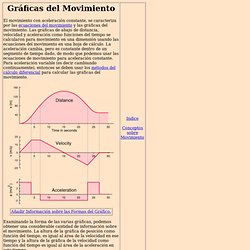
La altura de la gráfica de posición como función del tiempo, es igual al área neta de la velocidad en ese tiempo y la altura de la gráfica de la velocidad como función del tiempo es igual al área neta de la aceleración. En este ejemplo, donde la posición inicial y la velocidad fueron cero, la altura de la curva de posición es una medida del área neta bajo la curva de velocidad. La altura de la curva de posición aumentará siempre y cuando la velocidad sea constante. Cuando la velocidad se hace negativa, la curva de posición cae tanto como el area neta bajo la curva de velocidad.
Dynamic Force Analysis. Moments & C. of Mass. Moment of Inertia Concepts. Angular Momentum video. Moment of Inertia 2. Moment of Inertia: The moment of inertia of a system about some rotational point is the measure of an object's resistance to a change in the object's angular acceleration due to the action of a torque.
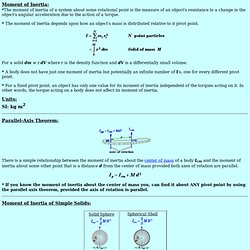
The moment of inertia depends upon how an object's mass is distributed relative to it pivot point. For a solid dm = r dV where r is the density function and dV is a differentially small volume. Moment of inertia. A tightrope walker uses the moment of inertia of the long rod to help maintain balance.

This is Samuel Dixon crossing the Niagara river in 1890. Moment of inertia is the mass property of a rigid body that defines the torque needed for a desired angular acceleration about an axis of rotation. Moment of inertia depends on the shape of the body and may be different around different axes of rotation. A larger moment of inertia around a given axis requires more torque to increase the rotation, or to stop the rotation, of a body about that axis. Moment of inertia depends on the amount and distribution of its mass, and can be found through the sum of moments of inertia of the masses making up the whole object, under the same conditions. . , then . For planar movement of a body, the trajectories of all of its points lie in parallel planes, and the rotation occurs only about an axis perpendicular to this plane.
Introduction[edit] Simple pendulum[edit] Center of Gravity. List of moments of inertia. In physics and applied mathematics, the mass moment of inertia, usually denoted I, measures the extent to which an object resists rotational acceleration about an axis, and is the rotational analogue to mass.
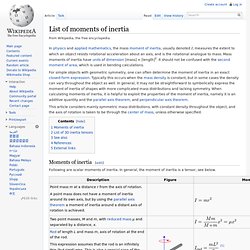
Mass moments of inertia have units of dimension [mass] × [length]2. It should not be confused with the second moment of area, which is used in bending calculations. For simple objects with geometric symmetry, one can often determine the moment of inertia in an exact closed-form expression. Typically this occurs when the mass density is constant, but in some cases the density can vary throughout the object as well. In general, it may not be straightforward to symbolically express the moment of inertia of shapes with more complicated mass distributions and lacking symmetry.
This article considers mainly symmetric mass distributions, with constant density throughout the object, and the axis of rotation is taken to be through the center of mass, unless otherwise specified. Vectors. © Department of Physics, University of Guelph In this tutorial we will examine some of the elementary ideas concerning vectors.
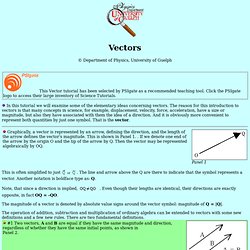
The reason for this introduction to vectors is that many concepts in science, for example, displacement, velocity, force, acceleration, have a size or magnitude, but also they have associated with them the idea of a direction. And it is obviously more convenient to represent both quantities by just one symbol. That is the vector. This is often simplified to just . Note, that since a direction is implied, Vectors and Calculus. Let’s start this section off with a quick discussion on what vectors are used for.

Vectors are used to represent quantities that have both a magnitude and a direction. Good examples of quantities that can be represented by vectors are force and velocity. Both of these have a direction and a magnitude. Let’s consider force for a second. A force of say 5 that is applied in a particular direction can be applied at any point in space. The same idea holds more generally with vectors. In a graphical sense vectors are represented by directed line segments. Points and Vectors. N2003 Replay Analyzer. Car Physics. Car Physics for Games by Marco Monster Level: Advanced Abstract: An introduction to car physics modelling for games. version 1.9 November, 2003 Introduction This tutorial is about simulating cars in games, in other words vehicle physics.
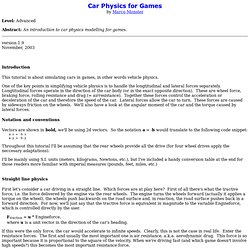
One of the key points in simplifying vehicle physics is to handle the longtitudinal and lateral forces separately. Notation and conventions Vectors are shown in bold, we'll be using 2d vectors. Throughout this tutorial I'll be assuming that the rear wheels provide all the drive (for four wheel drives apply the neccesary adaptations). I'll be mainly using S.I. units (meters, kilograms, Newtons, etc.), but I've included a handy conversion table at the end for those readers more familiar with imperial measures (pounds, feet, miles, etc.) Straight line physics. Physics of Car Racing.